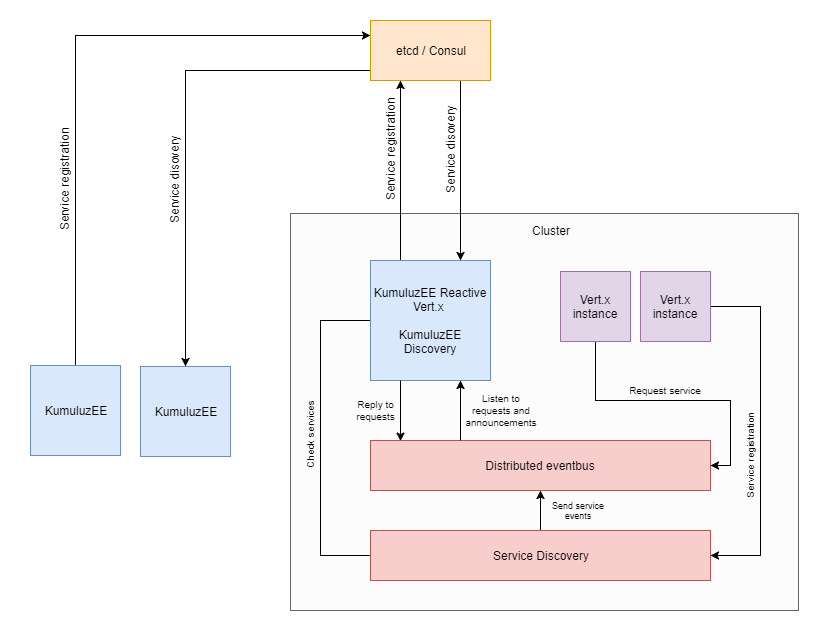KumuluzEE Reactive project for developing reactive microservices.
KumuluzEE Reactive is a project for using reactive patterns with the KumuluzEE microservices. It provides support for integrating KumuluzEE microservices with various reactive frameworks, such as Vert.x, ReactiveX, etc. KumuluzEE Reactive has been designed to support modularity with pluggable reactive frameworks.
Currently, Vert.x is supported. In the future, other reactive frameworks will be supported too (contributions are welcome).
KumuluzEE Reactive Vert.x provides integration with Vert.x distributed event bus and integration with Vert.x service discovery. It provides easy-to-use annotations for developing microservices that listen to or produce messages on the Vert.x distributed event bus and a service discovery bridge for importing and exporting services from Vert.x service discovery to KumuluzEE Service Discovery (for Consul and etcd).
As shown in the image below, the microservice that is using KumuluzEE Reactive Vert.x extension communicates to other Vert.x instances via distributed event bus. Both have to be started in a mode called clustered, so that they are able to find each other. After that, they can start to listen to a given address or publish events on the event bus.
Vert.x passes all of its events to the event handlers when they are available. In most cases, Vert.x call handlers are using a thread called event loop. One Vert.x instance can maintain multiple event loops. This means that a single Vert.x process easily can scale across a server.
If you want to learn more, click here.
You can enable KumuluzEE Reactive with Vert.x by adding the following dependency:
<dependency>
<groupId>com.kumuluz.ee.reactive</groupId>
<artifactId>kumuluzee-reactive-vertx</artifactId>
<version>${kumuluzee-reactive-vertx.version}</version>
</dependency>Vert.x is configured with the common KumuluzEE configuration framework. Configuration properties can be defined with the environment variables or with the configuration files. Alternatively, they can also be stored in a configuration server, such as etcd or Consul (for which the KumuluzEE Config extension is required). For more details see the KumuluzEE configuration wiki page and KumuluzEE Config.
Listed below are all the properties available for Vert.x configuration:
kumuluzee:
env:
name: dev
reactive:
vertx:
blocked-thread-check-interval: 1000
event-loop-pool-size: 16
file-caching-enabled: true
ha-enabled: false
ha-group: __DEFAULT__
internal-blocking-pool-size: 20
max-event-loop-execute-time: 2000000000
max-worker-execute-time: 60000000000
quorum-size: 1
worker-pool-size: 20
clustered: true
cluster-host: localhost
cluster-port: 0
cluster-ping-interval: 20000
cluster-ping-reply-interval: 20000
cluster-public-port: null
cluster-public-port: -1
discovery:
env:
name: dev
ttl: 30
ping-interval: 10
Properties blocked-thread-check-interval, cluster-ping-interval, cluster-ping-reply-interval and scan-period are set in milliseconds, while max-event-loop-execute-time and max-worker-execute-time are set in nanoseconds.
For injecting the Vert.x event bus message producer, KumuluzEE Reactive provides a @ReactiveEventPublisher annotation which will inject a message producer. A use of @Inject annotation is also needed. The annotation accepts one parameter, which is by default set to publisher.
Example of using the following annotation:
@Inject
@ReactiveEventPublisher(address = "event-name")
MessageProducer<Object> messageProducer;For listening to Vert.x event bus, KumuluzEE Reactive provides the @ReactiveEventListener annotation. Use of @Inject annotation is also needed. The annotation accepts one parameter which is by default listener. The annotation itself can be used on top of any method as long as it has one parameter of type Message<Object>. We can also reply to a message as shown in the example below.
Example of using the following annotation:
@ReactiveEventListener(address = "event-name")
public void onMessage(Message<Object> event) {
if(event.body() != null) {
event.reply("Message received.");
}
}KumuluzEE Reactive extension provides a bridge between Vert.x Service Discovery and KumuluzEE Discovery (for etcd and Consul). To enable the bridge import either one of the following dependencies
kumuluzee-discovery-etcdkumuluzee-discovery-consul.
Listed below are all the properties available for bridge configuration:
kumuluzee:
reactive:
vertx:
discovery:
env:
name: dev
ttl: 30
ping-interval: 20ping-interval: an interval in which service updates registration key value in the store. Default value is 20.ttl: time to live of a registration key in the store. Default value is 30 seconds.env.name: environment in which service is registered. If not providedkumuluzee.env.nameis used, which has a default value ofdev.
KumuluzEE Reactive Vert.x extension forms a cluster with other Vert.x instances, thus enabling the capturing of events
(e.g. registration of a service). Knowing that, we must start a microservice using kumuluzee.reactive.vertx.cluster
set to true. The following image illustrates how the bridge works.
When registering a service in Vert.x Service Discovery you can override the above parameters by adding additional metadata
to a Record.
In the example below we will set ttl to 20, ping-interval to 15, env to vertx and version to 1.1.0.
version: version of service to be registered. Default value is1.0.0.
Record record = HttpEndpoint.createRecord("some-rest-api", "localhost", 8080, "/");
record.setMetadata(new JsonObject().put("ttl", 20).put("ping-interval", 15)
.put("env", "vertx").put("version", "1.1.0"));To request for a service within a Vert.x instance, send a JSON, describing a service you want to retrieve, to
an address vertx.discovery.request on the eventbus.
In the example below we request for a service customers-service with version 1.0.0 located in dev
environment.
JsonObject service = new JsonObject().put("name", "customer-service")
.put("version", "1.0.0")
.put("env", "dev");
vertx.eventBus().send("vertx.discovery.request", service, ar -> {
if (ar.succeeded()) {
JsonObject reply = (JsonObject) ar.result().body();
// ...
} else {
// Handle error
}
});If the annotations are not enough KumuluzEE Reactive provides util classes which consist of helper methods for taking advantage of additional features offered by Vert.x.
Example of getting a reference to Vert.x instance:
Vertx vertx = VertxUtils.getInstance().getVertx();
// ...Example of getting a reference to Service Discovery instance:
ServiceDiscovery discovery = VertxUtils.getInstance().getServiceDiscovery();
// ...Recent changes can be viewed on Github on the Releases Page
See the contributing docs
When submitting an issue, please follow the guidelines.
When submitting a bugfix, write a test that exposes the bug and fails before applying your fix. Submit the test alongside the fix.
When submitting a new feature, add tests that cover the feature.
MIT


